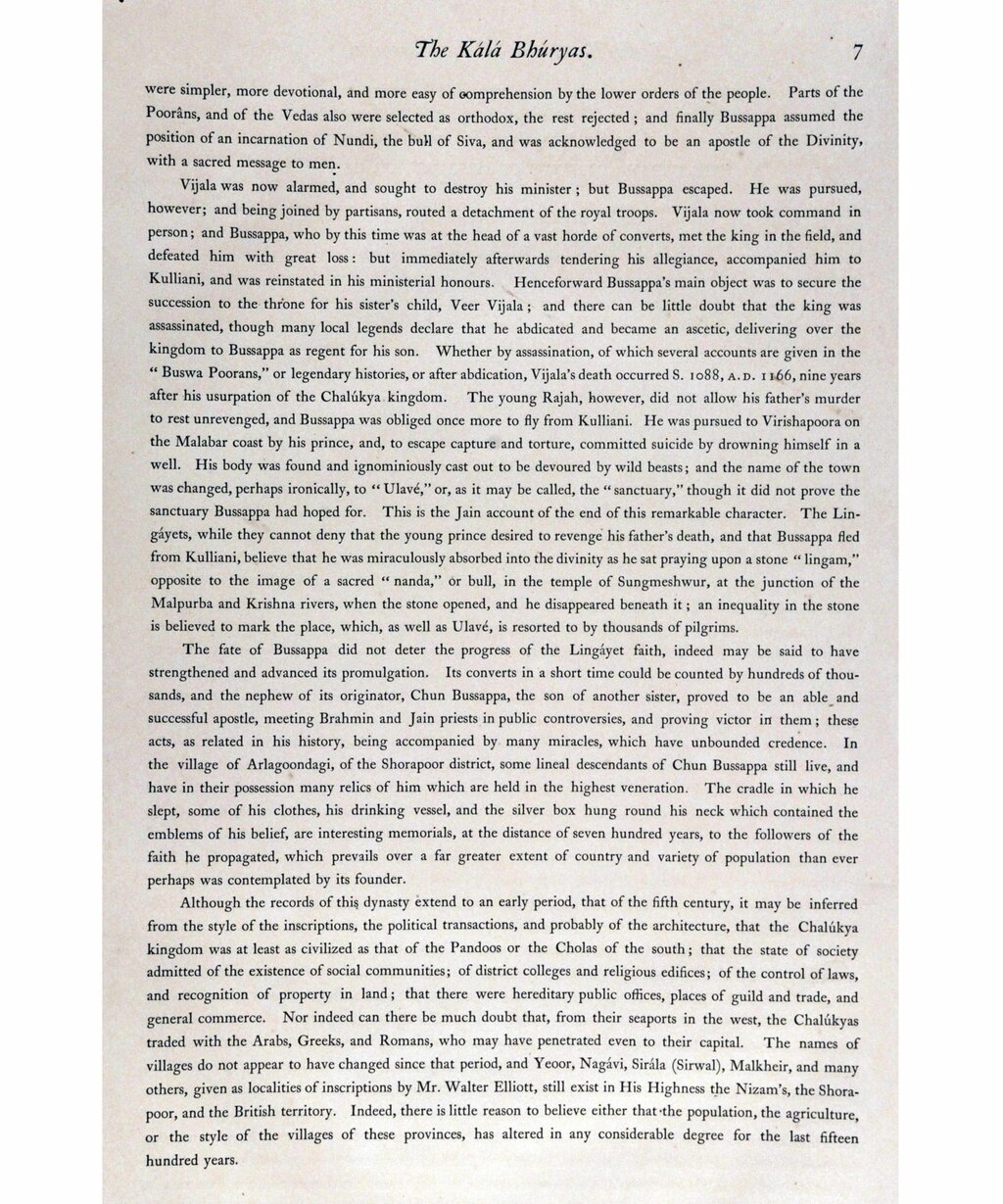were simpler, more devotional, and more easy of oomprehension by the lower orders of the people. Parts of the Poorans, and of the Vedas also were selected as orthodox, the rest rejected ; and finally Bussappa assumed the position of an incarnation of Nundi, the bull of Siva, and was acknowledged to be an apostle of the Divinity, with a sacred message to men.
Vijala was now alarmed, and sought to destroy his minister ; but Bussappa escaped. He was pursued, however; and being joined by partisans, routed a detachment of the royal troops. Vijala now took command in person; and Bussappa, who by this time was at the head of a vast horde of converts, met the king in the field, and defeated him with great loss: but immediately afterwards tendering his allegiance, accompanied him to Kulliani, and was reinstated in his ministerial honours. Henceforward Bussappa’s main object was to secure the succession to the throne for his sister’s child, Veer Vijala ; and there can be little doubt that the king was assassinated, though many local legends declare that he abdicated and became an ascetic, delivering over the kingdom to Bussappa as regent for his son. Whether by assassination, of which several accounts are given in the “ Buswa Poorans,”or legendary histories, or after abdication, Vijala’s death occurred S. 1088,a.d. 1166, nine years after his usurpation of the Chalukya kingdom. The young Rajah, however, did not allow his father’s murder to rest unrevenged, and Bussappa was obliged once more to fly from Kulliani. He was pursued to Virishapoora on the Malabar coast by his prince, and, to escape capture and torture, committed suicide by drowning himself in a well. His body was found and ignominiously cast out to be devoured by wild beasts; and the name of the town was changed, perhaps ironically, to “ Ulave,” or, as it may be called, the “ sanctuary,” though it did not prove the sanctuary Bussappa had hoped for. This is the Jain account of the end of this remarkable character. The Lingayets, while they cannot deny that the young prince desired to revenge his father’s death, and that Bussappa fled from Kulliani, believe that he was miraculously absorbed into the divinity as he sat praying upon a stone “ lingam,” opposite to the image of a sacred “ nanda,” or bull, in the temple of Sungmeshwur, at the junction of the Malpurba and Krishna rivers, when the stone opened, and he disappeared beneath it; an inequality in the stone is believed to mark the place, which, as well as Ulave, is resorted to by thousands of pilgrims.
The fate of Bussappa did not deter the progress of the Lingayet faith, indeed may be said to have strengthened and advanced its promulgation. Its converts in a short time could be counted by hundreds of thou sands, and the nephew of its originator, Chun Bussappa, the son of another sister, proved to be an able and successful apostle, meeting Brahmin and Jain priests in public controversies, and proving victor in them; these acts, as related in his history, being accompanied by many miracles, which have unbounded credence, In the village of Arlagoondagi, of the Shorapoor district, some lineal descendants of Chun Bussappa still live, and have in their possession many relics of him which are held in the highest veneration. The cradle in which he slept, some of his clothes, his drinking vessel, and the silver box hung round his neck which contained the emblems of his belief, are interesting memorials, at the distance of seven hundred years, to the followers of the faith he propagated, which prevails over a far greater extent of country and variety of population than ever perhaps was contemplated by its founder.
Although the records of this dynasty extend to an early period, that of the fifth century, it may be inferred from the style of the inscriptions, the political transactions, and probably of the architecture, that the Chalukyakingdom was at least as civilized as that of the Pandoos or the Cholas of the south; that the state of society admitted of the existence of social communities; of district colleges and religious edifices; of the control of laws,and recognition of property in land; that there were hereditary public offices, places of guild and trade, and general commerce. Nor indeed can there be much doubt that, from their seaports in the west, the Chalukyas traded with the Arabs, Greeks, and Romans, who may have penetrated even to their capital. The names of villages do not appear to have changed since that period, and Yeoor, Nagavi, Sirala (Sirwal), Malkheir, and many others, given as localities of inscriptions by Mr. Walter Elliott, still exist in His Highness the Nizam’s, the Shorapoor, and the British territory. Indeed, there is little reason to believe either that-the population, the agriculture, or the style of the villages of these provinces, has altered in any considerable degree for the last fifteen hundred years.
